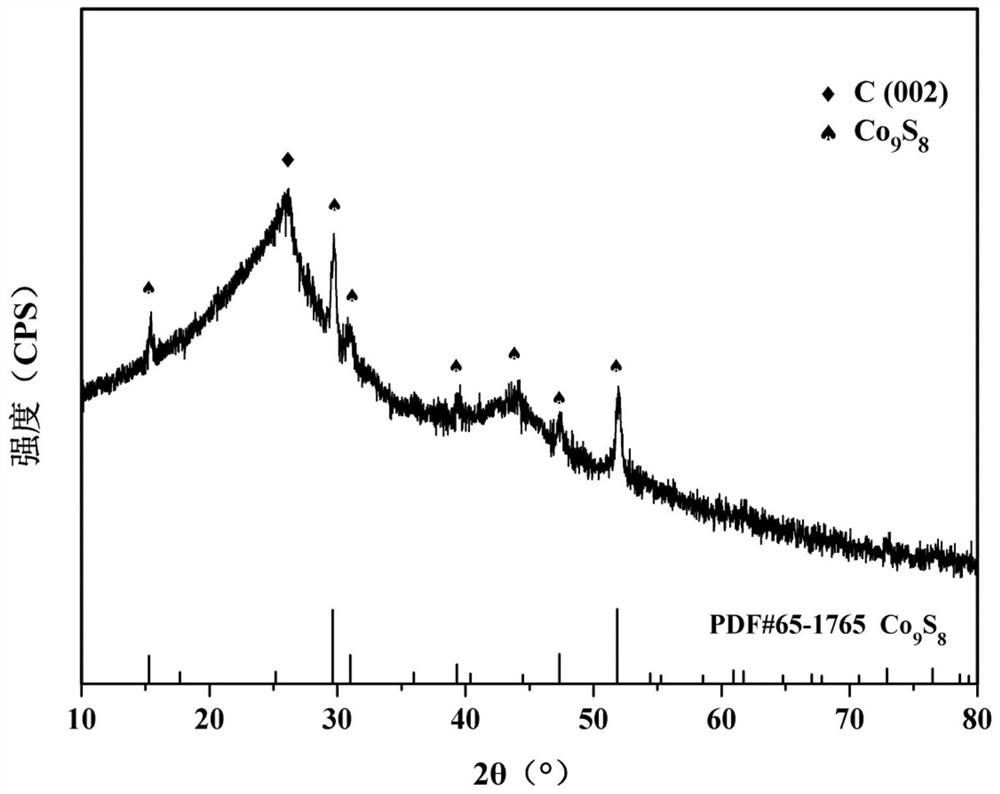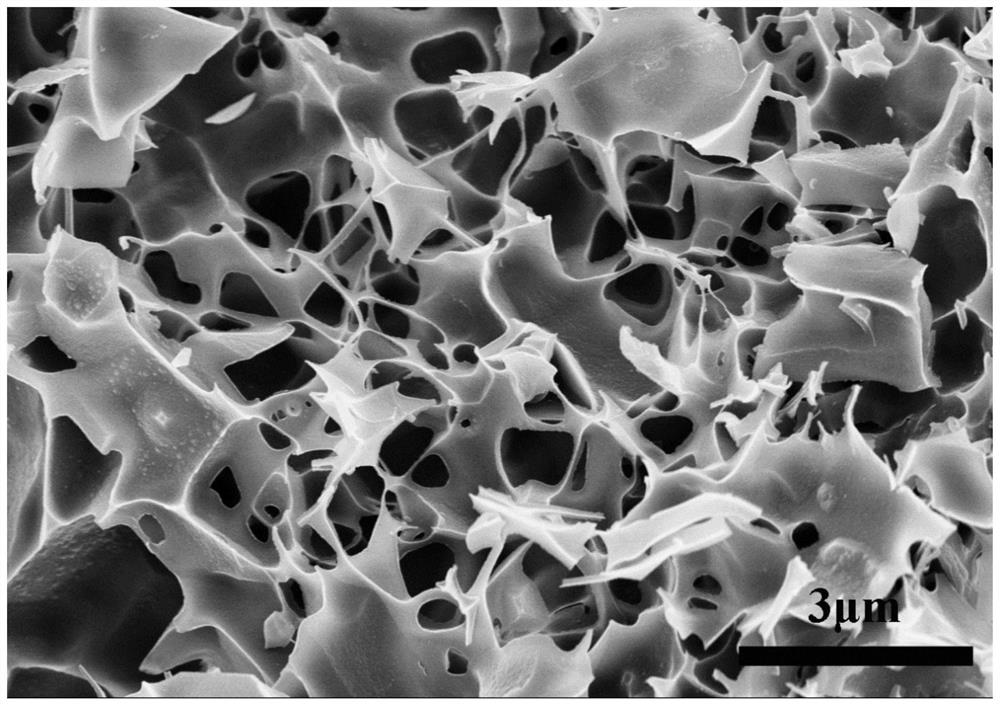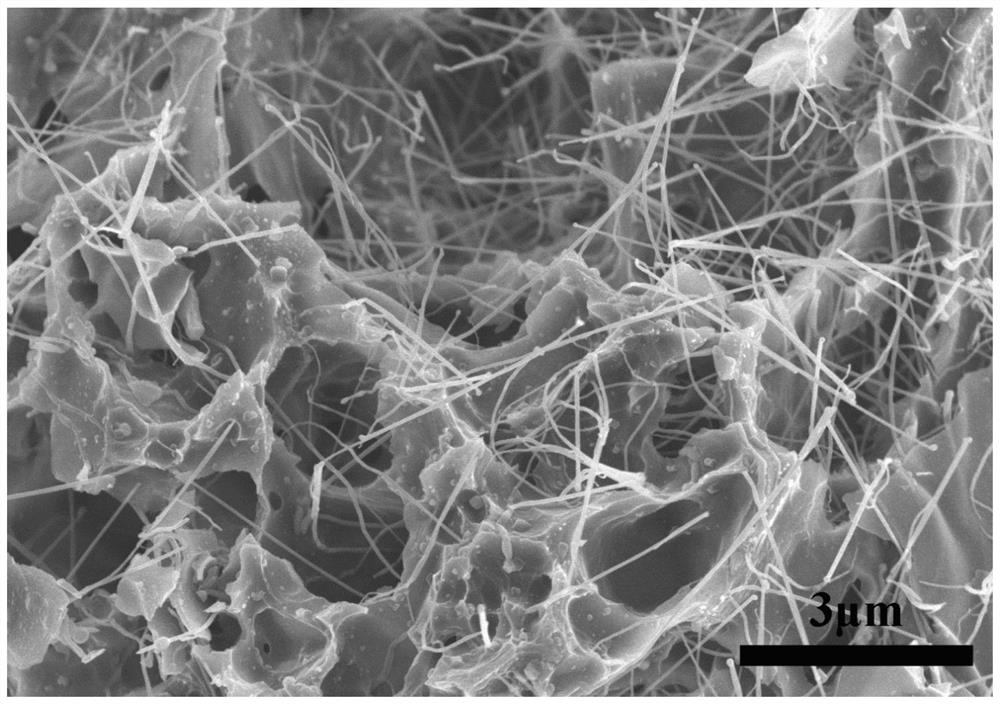A kind of porous carbon@carbon nanotube absorbing material and its preparation method
A carbon nanotube and wave-absorbing material technology, applied in the field of material science, can solve the problems of large filling amount and unfavorable application
- Summary
- Abstract
- Description
- Claims
- Application Information
AI Technical Summary
Problems solved by technology
Method used
Image
Examples
Embodiment 1
[0046] A method for preparing porous carbon@carbon nanotube wave-absorbing material using sodium chloride as a template, comprising the following steps:
[0047] (1) Firstly, 0.9 g of thiourea was dispersed in 12 mL of saturated sodium chloride solution to obtain mixed solution A.
[0048] (2) Then add 0.9g of sucrose into the mixed solution A and disperse evenly to obtain the mixed solution B.
[0049] (3) 0.03g cobalt chloride hexahydrate is added in the mixed solution B to obtain the mixed solution C;
[0050] (4) The mixed solution C was sonicated at 600W for 0.8h, then 100mL of liquid nitrogen was added, and freeze-dried for 24h to obtain solid D;
[0051] (5) The solid D was heated up to 590° C. at 1° C. / min under an argon atmosphere, and then kept for 1.5 h to obtain solid E.
[0052] (6) Grinding the solid E, adding deionized water, ultrasonication at 600W for 4 hours, filtration, and vacuum drying at 75°C for 11 hours to obtain solid F.
[0053] (7) After the solid F...
Embodiment 2
[0055] A method for preparing porous carbon@carbon nanotube wave-absorbing material using sodium chloride as a template, comprising the following steps:
[0056] (1) First, 1 g of thiourea was dispersed in 12 mL of saturated sodium chloride solution to obtain mixed solution A.
[0057] (2) Then add 1 g of sucrose into the mixed solution A and disperse evenly to obtain the mixed solution B.
[0058] (3) 0.03g cobalt chloride hexahydrate is added in the mixed solution B to obtain the mixed solution C;
[0059] (4) The mixed solution C was sonicated at 600W for 1 hour, then 150 mL of liquid nitrogen was added, and freeze-dried for 24 hours to obtain solid D;
[0060] (5) The solid D was heated up to 600° C. at 2° C. / min under an argon atmosphere, and then kept for 2 hours to obtain solid E.
[0061] (6) After grinding the solid E, add deionized water, sonicate at 600W for 5h, filter, and vacuum dry at 80°C for 12h to obtain solid F.
[0062] (7) After the solid F was heated up...
Embodiment 3
[0064] A method for preparing porous carbon@carbon nanotube wave-absorbing material using sodium chloride as a template, comprising the following steps:
[0065] (1) Firstly, 1.1 g of thiourea was dispersed in 12 mL of saturated sodium chloride solution to obtain mixed solution A.
[0066] (2) Then add 1.1 g of sucrose into the mixed solution A and disperse evenly to obtain the mixed solution B.
[0067] (3) 0.03g cobalt chloride hexahydrate is added in the mixed solution B to obtain the mixed solution C;
[0068] (4) The mixed solution C was sonicated at 600W for 1.2h, then 200mL of liquid nitrogen was added, and freeze-dried for 24h to obtain solid D;
[0069] (5) The solid D was heated up to 610° C. at 3° C. / min under an argon atmosphere, and then kept for 2.5 hours to obtain solid E.
[0070] (6) Grinding the solid E, adding deionized water, ultrasonication at 600W for 6 hours, filtration, and vacuum drying at 85°C for 13 hours to obtain solid F.
[0071] (7) The solid ...
PUM
| Property | Measurement | Unit |
|---|---|---|
| thickness | aaaaa | aaaaa |
Abstract
Description
Claims
Application Information
 Login to View More
Login to View More - Generate Ideas
- Intellectual Property
- Life Sciences
- Materials
- Tech Scout
- Unparalleled Data Quality
- Higher Quality Content
- 60% Fewer Hallucinations
Browse by: Latest US Patents, China's latest patents, Technical Efficacy Thesaurus, Application Domain, Technology Topic, Popular Technical Reports.
© 2025 PatSnap. All rights reserved.Legal|Privacy policy|Modern Slavery Act Transparency Statement|Sitemap|About US| Contact US: help@patsnap.com



